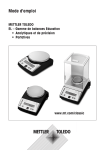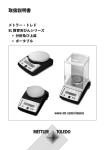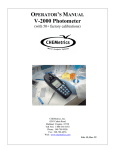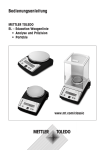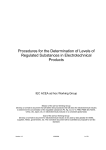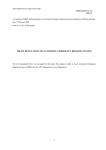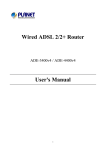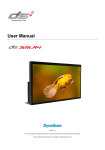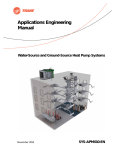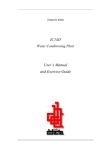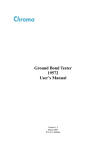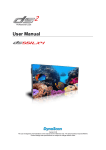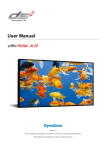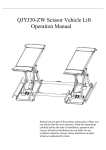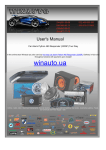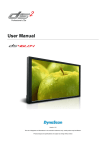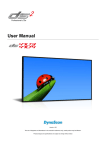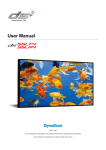Download EL403(2005
Transcript
EL403. Dishwashers
[EL403-2000/4/2005-107]
1. Scope
This criteria shall apply to electric dishwashers (hereinafter referred to as "dishwasher")
which wash trays or utensils, limited to 20 or less person-capacity batch dishwashers
and 2000 tray/h capacity continuous dishwashers.
2. Definitions
2.1
“Batch system washer” is usually used at home. After trays and utensils are put into the
dishwasher, it proceeds with all or some of the stages of wash/rinse/dry according to
the given washing program.
2.2
“Continuous system washer” is usually used in large feeding facilities. Trays and
utensils can be continuously put into the dishwasher while it is conducting all stages of
wash/rinse/dry according to the given washing program.
2.3
“Wash capacity” is a functional unit indicating the number of trays/utensils the
dishwasher can wash per one operation or per unit time. To indicate the washing
capacity, these criteria use the number of functional units which a batch washer can
wash per one operation (no. of persons) and the number of functional units which a
continuous dishwasher can wash per hour (tray/h).
2.4
“Functional unit” is a quantified service (performance) of a product. In these criteria, the
functional unit of a batch dishwasher is the 'standard' number of trays and utensils
used by one person (for a person), while that of a continuous dishwasher is one
standard tray (tray).
1
2.5
“Water consumption” is the total amount of water consumed in all stages of
wash/rinse/dry for the number of trays equivalent to the washing capacity according to
the given washing program. When water consumption is set only for the washing stage,
it is the total amount of water consumed in the washing stage only.
2.6
“Electric power consumption” is the total amount of electricity consumed in all stages of
wash/rinse/dry for the number of trays equivalent to the washing capacity according to
the given washing program. When power consumption is set only for the washing stage,
it is the total amount of electricity consumed in the washing stage only.
2.7
“General type washer” refers to the washer using water jet in the cleansing process.
2.8
“Ultrasonic washer” refers to the washer using ultrasonic wave in the cleansing
process.
2.9
“Ozone depletion potential (ODP)” refers to the ratio of a particular ozone depleting
compound of environmental effect compared to the depleting ability of a standard
compound, CFC-11, which arbitrarily defined as 1.0.
3. Certification Criteria
3.1 Environmental Criteria
3.1.1
With respect to the consumption of energy and resources during the use stage, the
product shall satisfy the following requirements.
3.1.1.1
Batch system general type washers
2
a) Allowance of grade index for consumption efficiency in accordance with
「Regulations on management of efficiency control equipment」 in accordance with
「Energy Use Rationalization Act」 shall satisfy following requirements.
Cleansing Capacity
For Less Than 6 People
For More Than 6 People
R > 20.00
R > 25.00
Allowance of grade index for
consumption efficiency (R)
b) Water saving rating according to water consumption shall conform to the following
criteria.
Water saving rating
1
2
3
Water consumption per functional unit [L/no. person]
≤ 1.5
1.5 ~ 2.0
> 2.0
3.1.1.2
Batch system ultrasonic washers
a) Power consumption shall conform to the following criteria.
Cleansing Capacity
For Less Than 4 People
For More Than 4 People
Electric power consumption [Wh]
≤ 120
≤ 200
b) Water consumption at the washing stage shall be 30 L or less, and the water tank in
which trays are washed shall be marked with meters indicating suitable amounts of
water according to the washing capacity.
c) Water saving ratings according to water consumption shall conform to the following
criteria.
Water consumption rating
1
2
3
Water consumption in the washing stage [L]
≤ 15
15 ~ 20
> 20
3.1.1.3
Continuous washers
a) Power consumption per functional unit shall be 150 Wh/tray{129 kcal/tray} or less.
b) Water consumption per functional unit shall be 2.0 L/tray or less.
3
c) Water saving ratings according to water consumption shall conform to the following
criteria.
Water saving rating
1
2
3
Water consumption per functional unit [L/tray]
≤ 1.0
1.0 ~ 1.5
> 1.5
3.1.2
Use of chemicals and discharge of contaminants shall conform to the following criteria.
3.1.2.1
With respect to the use of detergent, the batch system washers shall satisfy the
following requirements.
a) There shall be the measuring indication in the detergent injection equipment of
general type washer, by which the appropriate amount of detergent can be put in
accordance with the level of contamination and the volume of cleansing, and the
designated amount of use shall be put precisely.
b) In case of ultrasonic washer, appropriate usage of detergent in comparison with the
water consumption in accordance with the level of contamination and the volume of
cleansing shall be provided in the description of product.
3.1.2.2
With respect to the use of detergent, the continuous washers shall satisfy the following
requirements.
a) When the given washing program allows the use of detergent, the detergent inlet of
a dishwasher shall allow users to adjust the amount of detergent according to the
degree of contamination and the washing capacity. In addition, the dishwasher shall be
able to reuse detergent liquid in the washing stage so as to save detergent.
b) After completing the given washing program with rinse liquid not used, the washed
trays shall be dried sufficiently.
3.1.2.3
The noise of a dishwasher (sound pressure level) when its movement during washing
4
has been stabilized shall conform to the following criteria.
Item
Batch general type washer Batch ultrasonic washer
≤ 50
Criteria of sound pressure level [dB(A)]
≤ 70
3.1.3
With respect to the recycling capability of the product in the manufacturing process and
the recycling or disposal stage, the product shall satisfy the following requirement.
Note) This Criteria shall not applied on materials which are exempted from Hazardous
Substances Restriction lists on EU Directive 2002/95/EC and lead in solder of printed circuit
board (PCB). However, in case of revision of EU Directive 2002/95/EC, this shall follow revised
EU Directive which is applicable at the time the application for eco-label certification
3.1.3.1
Lead, cadmium, mercury and their compounds, and hexavalent chromium compounds
shall not be used in product.
3.1.3.2
Content of lead, cadmium, mercury and hexavalent chromium 6+ in the parts of the
product shall comply with one of the following requirements.
a) The applicant shall have an appropriate system to control the content of hazardous
substances as following requirements.
Item
Pb
Cd
Hg
Criteria [mg/kg]
≤ 1000
≤ 100
≤ 1000
Hexavalent
Chromium
6+
≤ 1000
b) Provided that the applicant does not have an appropriate system for the control of
hazardous substances, the content of hazardous substances in the parts of the product
shall comply with the following requirements.
Item
Pb
Cd
Hg
Criteria [mg/kg]
≤ 1000
≤ 100
≤ 1000
Hexavalent
Chromium
≤ 1000
Note) In case the content of total chromium (Cr) is 1000 mg/kg or less, it is regarded as
equivalent
5
6+
3.1.3.3
PBBs (polybrominated biphenyls), PBDEs (polybrominated diphenyl ethers) and shortchain chlorinated paraffins (C= 10~13) whose chlorine concentration is 50% or more
shall not be used in the product.
3.1.4
With respect to recycling in manufacturing process and recyclability of the product at
disposal stage, the product shall comply with the following requirements.
3.1.4.1
Separable plastic parts (weighing 25g or more and covering a flat surface of 200mm2
or more) shall be visibly marked with material identification to facilitate separation and
collection in disposal.
3.1.4.2
Shock-absorbing materials in packaging of general washer shall be made of recycled
pulp or paper such as pulp mold. However, following materials are regarded as
equivalent.
a) Shock-absorbing materials certified according to 'EL 606. Packaging Materials'
b) Shock-absorbing materials manufactured by using more than 50wt% of recycled
plastics
c) EPS (expanded polystyrene), EPE (expanded polyethylene) and EPP (expanded
polypropylene) whose foaming agent has zero ODP
d) Air cell packing bubble wrap that injects air into synthetic resin.
3.1.5
The product shall be designed and manufactured with a perspective on resource- and
energy-saving, reduction of pollutant emission and hazardous substance use, recycled
material use, recyclability, lifespan extension, etc. in order to reduce environmental
impacts throughout the life cycle.
6
3.2 Quality Criteria
3.2.1
Quality of washer shall satisfy the relevant items of safety standard of electric
appliances in accordance with 「Electric Appliances Safety Control Act」.
3.2.2
Cleansing and drying performance of the product shall satisfy the following
requirements.
3.2.2.1
Batch general washers shall satisfy the ‘cleansing and drying performance’ of
「Regulations on management of efficiency control equipment」 in accordance with
「Energy Use Rationalization Act」.
3.2.2.2
Batch system ultrasonic washer shall prove to maintain enough cleansing performance
by showing the test result in accordance with other test methods standardized in
consideration of test methods suggested in <Annex2> and Korean dietary habits.
3.2.2.3
Continuous washers shall prove to maintain enough cleansing and drying performance
by showing the test result in accordance with other test methods standardized in
consideration of test methods suggested in <Annex3> and general working condition.
3.3 Consumer Information
3.3.1
Matters regarding regular filter cleaning and the removal of sediments in a dishwasher
3.3.2
Marking of consumer information, which represents the certification reason of the
product (reduction of water and detergent consumption, energy saving, and low level
noise), required to reduce the environmental load at the stage of product consumption
7
3.3.3
Mark the water saving rating of the pro
product.
duct. Note that the type of detailed information
marking among the environmental marking designs shall be used when marking the
water saving rating. (Refer to the following example.)
< Information of Eco-product >
Water
Water-saving level : General washing machine
achine for home use 1st grade
Water-saving rating
1st grade
2nd grade
3rd grade
Water
ater consumption [L/no. person]
≤1.5
1.5~2.0
>2.0
4. Test Methods
Certification Criteria
Test and Verification Methods
Test report byy an accredited testing laboratory in
accordance with 「Energy
Energy Use Rationalization Act
Act」 in
accordance with 「Regulations
Regulations on management of
3.1.1.1
efficiency
3.1.1
control
equipment」
of
test
methods
(however, there are no additional using cleaner) or
certificate of equivalent
Test report by an accredited testing laboratory in
3.1.1.2
accordance with the test methods 4.1 and 4.2.’
Test report by an accredited testing laboratory in
3.1.1.3
Environmental
Criteria
accordance with the test methods
ethods 4.1 and 4.
4.3.’
3.1.2.1
Verification of submitted document
a)
3.1.2
3.1.2.2
3.1.2.3
3.1.3.1
3.1.3
3.1.3.2
3.1.3.3
3.1.4~3.1.5
Quality Criteria
3.2.1
b)
Verification of submitted document
Test report by an accredited testing laboratory in
accordance with the test methods 4.1 and 4.3.’
Test report by an accredited testing laboratory in
accordance with the testt methods 4.1 and 4.
4.4.’
Verification of submitted document
Submitted document in accordance with verification
and test methods 4.5’.
Verification of submitted document
Verification of submitted document
Test report by an accredited testing laboratory in
8
accordance with the safety standard of electric
appliances or certificate of equivalent
Test report by an accredited testing laboratory in
accordance with 「Energy Use Rationalization Act」
3.2.2.1
of 'regulations on management of efficiency control
3.2.2
equipment’ or certificate of equivalent
3.2.2.2~
3.2.2.3
Consumer Information
Verification of submitted document
Verification of submitted document
Note) It does not matter that the evaluation result of cleansing and drying performance shall be
the one issued by either an accredited testing laboratory or a laboratory operated independently
by the applicant company
4.1 General Matters
4.1.1
One test sample shall be required for each applied product.
4.1.2
Test samples shall be collected at random by a certification institute from products in
market or those in storage at the production site. For a continuous dishwasher,
however, the deputy for environment mark certification may designate the continuous
dishwasher of a large feeding facility which uses the same model as the product for
which the application for the test has been made, and use it as a sample.
4.1.3
It makes a rule that all the measurements shall be conducted after setting up the
product at the usual use state and then the product reaches the normal state and
becomes stabilized.
4.1.4
Test result shall be numerically set according to according to KS Q 5002 (Statistical
interpretation method of the data – Part 1: Statistical description of the data).
4.1.5
Items on the setup and use of washer shall be in accordance with the standard
9
suggested by the manufacturer.
4.1.6
Surrounding conditions, power and provided water in test shall be as follows.
4.1.6.1
Surrounding temperature and humidity:
Temperature 20±5℃, Relative Humidity
55±10%
4.1.6.2.
Power for test: Rated electric power ±2%, rated frequency ±1%
4.1.6.3
Temperature of Feed water: 15±5℃ in principle
4.1.6.4
Pressure and hardness of Feed water: Under normal conditions, water hardness and
the supply pressure
4.2 Test Methods of the Electric Power Consumption and Water of Batch system
Ultrasonic Washer
4.2.1
Test shall be conducted by putting the tableware designated by the cleansing volume
of test product and the tableware attached with contaminating materials with in the
method suggested in the ‘<Annex1>.
4.2.2
In case of water consumption, measure the amount of water needed to fill up to the
appropriate level suggested by the manufacturer in the state of not putting tableware
into the cleansing water tub.
4.2.3
In case of electric power consumption, stage of cleansing the cumulative value of
10
electric power three times to get the averaged value. Dishwasher shall be left in the
natural state before every testing so that it shall be saturated with the specified
surrounding conditions. However, in case that the temperature of washer does little
affect the electric power consumption, it shall not be applied.
4.3 Method of the performance test for power consumption, water consumption,
and drying performance of a continuous dishwasher
4.3.1
The test shall conform to the method defined in Annex Table 2, and the dishwasher
shall be in the defined ambient conditions by leaving it alone under natural conditions
before each test. In addition, for the insertion of trays, the tray insertion rate shall be
adjusted such that the smallest value in the range of the washing capacity given by the
manufacturer can be applied, and in principle the trays to be used for the test shall be
those with contaminants.
4.3.2
Water consumption (QT) is the combined value of the mean value (Qm) of the three
measurements of the amount of water consumed in all the stages of wash/rinse/dry for
one hour from the starting of the dishwasher, and the amount of water (∑Qtank)
contained in the tank of the dishwasher when it is operated.
4.3.3
Power consumption (ET) shall be the mean value of the three measurements of the
accumulated value of electricity consumed during all the stages of wash/rinse/dry for
one hour from the starting of the dishwasher.
a) When the temperature of the supplied water is not exactly 15℃, or warm water is
supplied from outside, power consumption (ET) is the combined value of the mean
value (Em) of the measured power consumption values and the power consumption
correction value (EC1). The power consumption correction value (EC1) can be obtained
by using the following formula. The correction value according to the temperature of the
supplied water,
EC1 = [QT X (T-15)/860] [kWh]
11
Herein, QT: water consumption [L]
T : supplied water temperature [℃]
b) When energy sources other than electricity, such as oil, gas, and steam, are used
together with electricity for the dishwasher, the power consumption (ET) is the
combined value of the mean value (Em) of the measured power consumption values
and the power consumption conversion value (EC2) according to the use of energy
sources other than electricity. The power consumption conversion value (EC2) can be
obtained through the following formula.
The power consumption conversion value according to the use of other energy
resources than electricity, EC2 = mE X f [kWh]
Herein, mE: energy consumption [L (oil), kg (propane gas), N㎥(city gas), kg
(steam)]
f: Power consumption conversion factor
<Table> Power consumption conversion factor
Energy type
Kerosene
Propane
City gas
Steam
Conversion factor
10.1 kWh/L
14.0 kWh/㎏
8.14 kWh/N㎥
0.627 kWh/㎏
Note) The power consumption conversion factors for energy sources other than steam are the
values calculated by using the oil conversion factor according to Annex 1, the <Enforcement
Ordinance of the Energy Use Rationalization Act> enforceable as of June 2005.
4.3.4
Drying performance shall be evaluated according to the trays produced from the
dishwasher operated according to the method defined in Annex Table 2, and the trays
shall be 'dried sufficiently' according to the result of the evaluation.
4.4 Test Methods of Noise (Sound Pressure Level)
4.4.1
Noise should be measured with the following conditions, according to KS I ISO 1996-1
(Acoustics - Description, measurement and assessment of acoustics - Description,
measurement and assessment of environment noise - Part 1: Basic quantities and
assessment procedures). A sound level meter specified in KS C 1502 (Sound level
meters) shall be used, and the noise emission shall be determined in accordance with
the weighting network A.
12
4.4.2
Set up the washer on solid and safety place.
4.4.3
In case that it is not full anechoic chamber, the distance between the wall and the test
product shall be broad - more than 2m - enough not to make reflected sound, and the
difference between background noise and measured noise shall be at least more than
10dB(A).
4.4.4
The test shall be conducted by proceeding with all or certain stages of wash/rinse/dry
according to the given washing program or washing method, with the dishwasher
loaded to the washing capacity by inserting trays and utensils.
4.4.5
The noise shall be shown as the noise from the direction making biggest noise among
the averaged figure measured three times at the point 1m away from the left side, right
side, front and middle parts of the product, respectively by cleansing cycle and position,
with sound level meter. However, in case that the noise distribution by cleansing
stage∙position can be estimated in advance with an appropriate method, the noise shall
be measured only on the concerned stage and position, and it does not matter to make
it the result.
4.5 Compliance verification and test method regarding the control of hazardous
substances
4.5.1
Verification method for the hazardous substance management system
Note) This is the method to verify the compliance with the requirement of the restriction of the
use of lead, cadmium, mercury and their compounds, and hexavalent chromium compounds in
the parts of the product. This method is applicable to verify that the applicant properly controls
PBBs (polybrominated biphenyls), PBDEs (polybromodiphenyl ethers) and short-chain
chlorinated paraffins (C=10~13).
4.5.1.1
13
Compliance verification shall be done by one of the following documents or more.
a) Explanatory note on the management system, established by the manufacturer on
purpose to control the hazardous substances when each part of the product is supplied
from the suppliers, and relevant documents.
b) Test result conducted by the manufacturer in order to control the hazardous
substances when each part of the product is supplied from the suppliers (In this case,
test method including pre-conditioning method applied shall be specified in detail).
c) Certificate issued by the accredited third party showing that each part of the product
satisfies the relevant requirements (e.g. 'EL 763. Electric and Electronic Parts’).
d) Other documents showing that the manufacturer properly controls the hazardous
substances when each part of the product is supplied from the suppliers.
4.5.1.2
In case the compliance of the management system cannot be verified by ‘4.3.1.1’ or
the test result for specific parts of the product is required by deliberation committee of
eco-label certification, compliance verification shall be done by the following '4.3.2 Test
method for measuring the content of the hazardous substances' for the parts collected
at random by eco-label certification body.
4.5.2
Test method for measuring the content of the hazardous substances
Note) This is one of the test methods applicable to verify the content of lead (Pb), cadmium (Cd),
6+
mercury (Hg) and hexavalent chromium (Cr ) contained in the parts of the product. The content
of the hazardous substances can be also verified according to the internationally recognized
test methods. In this case, test method including pre-conditioning method shall be specified in
detail and the specified test method shall be approved by deliberation committee of eco-label
certification.
4.5.2.1
The parts for the test shall be collected at random by eco-label certification body.
14
4.5.2.2
Test samples shall be homogenized by pre-conditioning method such as pulverization
of each part.
4.5.2.3
Analysis method of lead (Pb), cadmium (Cd), mercury (Hg), hexavalent chromium
(Cr6+), total chromium (Cr)
a) Lead (Pb), cadmium (Cd): KS M 0016 (General rules for atomic absorption
spectrochemical
analysis),
KS
M
0032
(General
rules
for
ICP
emission
spectrochemical analysis) and Inductively coupled plasma mass spectrometry (ICP-MS)
b) Mercury (Hg): Atomic absorption spectrochemical analysis by using gold
amalgamation method and KS M 0016 (General rules for atomic absorption
spectrochemical analysis)
c)
Hexavalent
chromium
(Cr6+):
Ultraviolet
spectrophotometric
analysis
by
diphenylcarbazide and Ultraviolet spectrophotometric analysis by lead acetate
trihydrate.
d) Total chromium (Cr): KS M 0016 (General rules for atomic absorption
spectrochemical
analysis),
KS
M
0032
(General
rules
for
ICP
emission
spectrochemical analysis) and Inductively coupled plasma mass spectrometry (ICP-MS)
5. Reasons for Certification
5.1 Batch system general type washer: “Water and power saving, less detergent usage,
low noise”
5.2 Batch system ultrasonic washer: “Water and power saving, less detergent usage”
5.3 Continuous washer: “Water and power saving, less detergent usage”
15
<Annex1> Test Methods of Cleansing Performance of Batch Ultrasonic
Washer [related to ‘3.2.2 of 3.2 Quality standards']
Note) This test method is standardized to evaluate objectively the cleansing performance of
batch ultrasonic washer. Apart from these test methods, in case that the ways of evaluating
objectively the cleansing performance of batch ultrasonic washer manufactured in consideration
of Korean dietary habits are suggested, the concerned test methods can be applied.
1. General Matters
1.1
Test of cleansing performance shall be estimated as the average value through
repeating test twice.
1.2
It makes a rule that every measurement shall be tested at the stabilized state reaching
the normal state after setting the product in the usual use state.
2. Test Methods
2.1 Test Equipment and Material
2.1.1
It makes a rule to use the standard detergent designated by the manufacturer.
However, in case that the manufacturer does not designate standard detergent,
detergent satisfying environmental mark certification criteria can be used.
2.1.2
Composition of tableware used for one time by the shape and type of tableware for test
load and the volume of washer shall be prepared in accordance with 6.3.2. (tableware
used as test load) of <Annex 9> of 'regulations on management of efficiency control
equipment in accordance with Energy Use Rationalization Act.
2.1.3
Contaminating materials shall be prepared newly in accordance with 6.3.3
(contaminating material needed for cleansing performance) of <Annex 9> of
「regulations on management of efficiency control equipment」 in accordance with
「Energy Use Rationalization Act」 whenever conducting tests.
2.2 Cleansing test
2.2.1 Setup of Washer
2.2.1.1
Items on the setup and use of washer shall be in accordance with the standard
suggested by the manufacturer.
16
2.2.1.2
It makes a rule that the temperature and hardness of feed water shall be as specified in
4.1.1 of Test Methods. In case that the temperature and hardness of supplementary
water are different from these, record the conditions in the test result.
2.2.2 Operation of Washer
2.2.2.1
It makes a rule to use the standard amount of standard detergent suggested by the
manufacturer. However, in case that the standard amount is not suggested, the
standard amount indicated on the packaging of standard detergent can be used as the
standard, and the amount shall be recorded in the test result.
2.2.2.2
There is no additional rinsing material use.
2.2.2.3
Arrange tableware∙apparatus with contaminated materials and operate the washer.
a) The way of attaching contaminating materials to the tableware shall be in
accordance with 6.3.4.1 (Contamination of Contaminated Material Tableware) of
<Annex 9> of 'regulations on management of efficiency control equipment in
accordance with Energy Use Rationalization Act.
b) It makes a rule to arrange tableware∙appliances with contaminated materials based
on the ways suggested by the manufacturer. In case that the ways of arrangement is
not suggested, the tableware shall be not or as less as possible, laid one upon another,
and the condition shall be recorded in the test result. Also, the tableware∙apparatus
shall be arranged in the same place in every test, and in case that the arrangement
does not affect the evaluation, this may not be observed.
c) It makes a rule to do the cleansing operation by applying the cleansing program or
method suggested by the manufacturer, and the applied cleansing program or method
shall be recorded in the test result.
d) Regarding the washer without the function of rinsing or drying, rinse the tableware
and appliances by applying usual ways such as rubbing and washing them lightly in
flowing water after the cleansing process. When rinsing, the flow amount of released
water of water tap shall be 6L/min, and natural or heated wind drying can be used.
2.3 Evaluation of Cleansing Performance
Evaluation of cleansing performance shall be in accordance with 6.3.6(evaluation) of
17
<Annex 9> of 'regulations on management of efficiency control equipment in
accordance with Energy Use Rationalization Act.
18
<Annex2> Test Methods of Cleansing Performance of Continuous Washer
[related to ‘3.2.2 of 3.2 Quality standards']
Note) This test method is standardized to evaluate objectively the cleansing performance of
continuous washer. Apart from these test methods, in case that the ways of evaluating
objectively the cleansing performance of continuous washer manufactured in consideration of
nature of Korean large cafeteria are suggested, the concerned test methods can be applied.
1. General Matters
1.1
Test of cleansing performance shall be estimated as the average value through
repeating test twice.
1.2
It makes a rule that every measurement shall be tested at the stabilized state reaching
the normal state after setting the product in the usual use state.
2. Test Methods
2.1 Test Equipment and Material
2.1.1
It makes a rule to use the standard detergent designated by the manufacturer.
However, in case that the manufacturer additionally supplies detergent only for one’s,
detergent is regarded as standard detergent.
CAS No.
Component
Ratio [%]
1310-58-3
Potassium hydroxide
15
10213-79-3
Sodium metasilicate, pentahydrate
7
Tetrasodium ethylenediamine tetraacetate (EDTA-4Na)
3
Sodium polyacrylate
3
64-02-8
9003-04-7
-
Deionized water
balance
Note) The index detergent should be used within six months of being manufactured.
2.1.2
In principle, the blue plates used for the test should be made of stainless steel, and be
400±20 mm in width and 295±15 mm in length. More than 120 pieces should be
prepared. Except for the blue plates to which pollutant is adhered, using those
containing other matter, such as melamine resin, may be accepted.
2.1.3
Prepare pollutants according to the following criteria and replace them for every test.
2.1.3.1 Grains of boiled rice
19
a) Pour rice that has been polished using the pounding method in less than s ix months
in sufficient water, quickly mix it, and then remove the water immediately. Rub it
vigorously and rinse it 3-4 times until the water becomes clean.
b) After soaking the rice in sufficient water for about 30 minutes during summer, or two
hours during winter, pour it into a sieve basket to drain the water.
c) Pour the rice and the water corresponding to about 1.1 times the amount of rice into
a cooker and then cook by normal means. If an electric rice cooker is used, follow the
user manual provided by the manufacturer.
d) Ensure the boiled rice is not sp oiled or dried during cooking and then make it within
eight hours of being cooked.
2.1.3.2 Egg yolk
a) Use a fresh 50-6 5g egg (refer to the expiry date).
b) Use at least three eggs. Separate the yolk from the white.
c) Mix the separated yolk well and store it in a refrigerator prior to use.
2.1.3.3 Kimchi
a) Use kimchi that conforms to the quality standards prescribed in K S H 2169 (Kimchi),
which is properly mature kimchi with a head.
b) Use powdered red pepper filtered with a standard sieve (with a mesh size of 1.7 mm)
in accordance with KS A 5101-1 (Test Sieves – Part 1: Test Sieves of Metal W ire).
2.1.3.4
With regard to margarine, mayonnaise, and ketchup, each to be used for the test
should meet corresponding Korean Industrial Standards and should be stored in a
refrigerator prior to use.
Section
Margarine
Mayonnaise
Ketchup
Corresponding Korean
KS H 2002
KS H 2109
KS H 2144
Industrial Standard
(Margarine)
(Mayonnaise )
(Tomato Ketchup)
2.2 Preparation of the blue plates to which pollutant s are to be adhered
2.2.1
The pollutants to be adhered to each part of a blue plate are as shown in the figure
below. A t least 100 blue plates should be prepared for testing.
20
mayonnaise
Kimchi juice +
ketchup +
+ yolk
powdered red pepper
mayonnaise
grains of boiled rice grains of boiled rice
+ kimchi juice
+ ketchup
Spread margarine evenly.
+ mayonnaise
Spread mashed grains of boiled rice
<Figure> How to adhere pollutant s to each part of a blue plate
2.2.2 Pollutant adherence shall be as follows:
a) Adhesion of grains of boiled rice: After completely mashing about 3 g of the grains of
boiled rice, adhere it to the corresponding part, (where boiled rice is normally placed),
and then leave it at room temperature for more than 30 minutes.
b) Adhesion of margarine: After leaving the margarine removed from a refrigerator at
room temperature for about one hour, apply around 2 g evenly to the corresponding
part of the blue plat e, (where a soup bowl is normally placed). Then leave it at room
temperature for more than 30 minutes.
c) Adhesion of mayonnaise + egg yolk: After satisfactorily mixing the mayonnaise and
egg yolk removed from a refrigerator at a proportion of 1 to 1, apply that pollutant of
about 2 g evenly to the corresponding part of a blue plate, (where a side dish is
normally placed; refer to the < figure > above), using a flat type brush (Type 28) as
prescribed in KS G 2103 (Artists’ Water Color B rushes). After adhesion, leave it at
room temperature for more than 30 minutes.
d) Adhesion of kimchi juice + powdered red pepper: After applying around 1 g of kimchi
juice evenly to the corresponding part of a blue plate, (where a side dish is normally
placed; refer to the < figure > above), using a flat type brush (Type 28) as prescribed in
KS G 2103 (Artists’ Water Color B rushes), sprinkle powdered red pepper evenly over
the soiled part with around 0.1 g of kimchi juice. After adhesion, leave it at room
temperature for more than 30 minutes.
e) Adhesion of ketchup + mayonnaise: After satisfactorily mixing the ketchup and
mayonnaise removed from a refrigerator at a proportion of 1 to 1, apply around 2 g of
that pollutant evenly to the corresponding part of a blue plate, (where a side dish is
21
normally placed; refer to the < figure > above), using a flat type brush (Type 28) as
prescribed in KS G 2103 (Artists’ Water Color B rushes). After adhesion, leave it at
room temperature for more than 30 minutes.
f) Adhesion of grains of boiled rice + kimchi juice: Apply around 0.5 g of kimchi juice
evenly to a quarter of the part where grains of boiled rice (refer to 1) above) are
adhered using a flat type brush (Type 28) as prescribed in KS G 2103 (Artists’ Water
Color B rushes). After adhesion, leave it at room temperature for more than 30 minutes.
g) Adhesion of grains of boiled rice + ketchup + mayonnaise: Mix the ketchup and
mayonnaise removed from a refrigerator satisfactorily at a proportion of 1 to 1. Apply
around 1 g of that pollutant evenly to a quarter of the part where grains of boiled rice
(refer to 1) above) are adhered, using a flat type brush (Type 28) as prescribed in KS G
2103 (Artists’ Water Color B rushes). After adhesion, leave it at room temperature for
more than 30 minutes.
2.3 Wash test
2.3.1 Installation of the washer
2.3.1.1
Install and use the dishwasher according to the standard prescribed by the
manufacturer.
2.3.1.2
Temperature and hardness of feed water in accordance with ‘4.1.1 Test methods’, and
set the water temperate at both wash and rinse stages according to the following table.
If there are any differences, record them in a corresponding test result report.
Section
Wash Stage
Rinse Stage
Water Temperature [ ℃ ]
65±1.5
80±3
2.3.2 Operation of washer
2.3.2.1
Use the standard amount of detergent suggested by the manufacturer, if the detergent
is a standard detergent. In the following cases, however, operate the dishwasher
without using detergent.
a) When the dishwasher has a system in which detergent is not used.
b) When the manufacturer has not suggested a standard amount of detergent.
2.3.2.2
There is no additional rising material use.
22
2.3.2.3
Operate the dishwasher and insert trays at a certain rate.
Note) Do not conduct rough washing on the blue plates where pollutant s are adhered before
being loaded in the washer. For those to which pollutant s have been adhered for more than
two hours, they can be soaked in a water tank at temperatures of lower than 65ºC within 30
minutes before being loaded in the washer.
a) In principle, the washer should be operated according to the washing program or
method outlined by the manufacturer. Record the applied washing program or method
in the corresponding test result report.
b) Adjust the speed of loading the blue plates so that the smallest value in the wash
capacity range outlined by the manufacturer can be applied.
c) In principle, blue plates to be loaded should have pollutants adhered. If soiled blue
plates cannot be prepared satisfactorily, however, put the equivalent pollutants in the
washer periodically to make up for any lack of pollutant load.
Note) The amount of pollutants to be adhered for each blue plate where there are no pollutants
previously adhered is as follows:
Pollutant Type
Loaded amount for
each blue plate[g]
Grains of
Boiled Rice
3
Margarine
Yolk
2
1
Kimchi
Juice
1.5
Mayonnaise Ketchup
2.5
1.5
d) The prepared blue plates for the adhesion of pollutant s are loaded at half the
amount after 10 minutes and then 40 minutes after the washer is operated. After being
washed, they will be used for the assessment of washing property performance.
2.3.2.4 Assessment of washing and drying performance
a) An assessment of washing and drying performance should be conducted on a total
of 100 blue plates as described below:
▪ 50 blue plates that were loaded 10 minutes after the washer was operated
▪ 50 blue plates that were loaded 40 minutes after the washer was operated
b) Drying performance shall be assessed 10 minutes within the blue plate is removed
from the washer and washing performance shall be assessed 10 minutes after the last
blue plate is removed from the washer. In principle, the assessment should be
conducted by one inspector at a location where a lamp of 1,000-1,500 Lux is installed 1
m above the test plates.
c) The assessment of washing performance is scored on each individual blue plate
according to the following table. Total assessment of washing performance is total
23
scores that sum the washing performance of each individual blue plate. If total
assessment of washing performance is higher than 90, washing performance will be
judged as being enough it.
<Table> Assessment of washing performance of Blue Plates
Evaluation
Score
Clean ( appropriate )
Assessment Criteria
No. of pollutants, n
Total soiled area, A [㎟]
1
≤4
≤4
Lightly soiled
0
4 < n ≤ 10
4 < A ≤ 20
Critically soiled
-1
> 10
> 20
d) The assessment of drying performance is scored on each individual blue plate
according to the following table. Total assessment of drying performance is total scores
that sum the drying performance of each individual blue plate. If total assessment of
drying performance is higher than 90, drying performance will be judged as being
enough it.
<Table> Assessment of drying performance of Blue Plates
Evaluation
Score
Assessment Criteria
Dry ( appropriate )
1
No water drops or moisture
Slightly wet
0
1 to 2 water drops, One moisture stripe
Critically wet
-1
3 or more water drops or exist stream of water
24
Common Criteria, Notice No. 2012-36, the Ministry of Environment
1. Eco-label products must follow the following provisions with regard to the proper
treatment of environmental pollution substances, such as air and water wastes and
noxious chemical substances emitted in the process of manufacturing or service
operation.
A. When first applying for certification, the product manufacturer should observe
the environment related laws and agreements pertaining to the region where the
production factory or the place of service operation is located for a period of one
year prior to the date of application. Any case of violation of the penalty clause
will be verified by confirming documents involved during a period of one year to
the date of application. Regarding any violation not related to the penalty clause,
confirmation will be made on the completion of appropriate measures.
B. A person who has received a certification of eco-labeling shall observe the
environment related laws and agreements pertaining to the region where the
production factory or the place of service operation is located during the period
of certification. However, regarding any violation besides a penalty, confirmation
will be made on the completion of appropriate measures.
2. As a general rule, information for consumers shall be indicated on the surface of
the product in such a way not to be easily erased. However, in case that indication
on the surface of the product is impossible or undesirable, it can be indicated on
the appropriate part such as product packaging, product guidebook and user’s
manual that consumers can recognize. However, the service information should be
indicated inside and outside of the place of service operation. In case that
indication inside and outside of the place of service operation is impossible or
undesirable, it can be indicated on the appropriate part such as an agreement,
letter of delivery, letter of guarantee, and PR materials that consumers can
recognize.
3. In order to establish fair trade and to protect consumer, the applicant for ecolabel and the holder of eco-label license shall observe the Act on the Fairness of
25
Indication and Advertisement with respect to the environmental aspects of the
product.
4. For Various standards referred in the certification criteria by target product, the
latest revised edition applies at the date of application, if not specified otherwise.
5. In applying the quality related criteria for each target product, if no standard is
available that can be applied as the quality criteria, the president of Korea
Environmental Industry & Technology Institute (KEITI) (hereafter referred to as
"president of KEITI") may establish and operate the quality criteria for the product
involved after review by a competent committee.
26


























